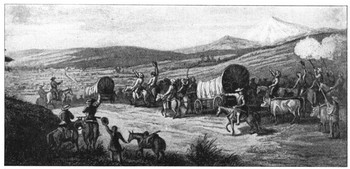The Santa Fe Trail
The Santa Fe Trail, as with other Trails West, got its name from its destination. In this case, the destination was a city first in Mexico (in the state of Nuevo) and then in New Mexico. 
Mexico gained independence from Spain in 1821. Not longer after that, the Santa Fe Trail was born. Trader William Becknell set out from Franklin, Mo., coaxing well-laden mules along a route of more than 900 miles through arid, hostile territory to, essentially, make money. When he arrived in Santa Fe, he found a willing market for what he was carrying. Others followed Becknell's example, the traffic escalating in numbers after the American victory in the Mexican-American War, after which the United States owned Santa Fe. In fact, American forces used Becknell's trail as an invasion route during the war. The Santa Fe Trail passed through what is now Kansas (nearly all of the length of the state), Colorado, and New Mexico. The Santa Fe Trail had more than its dangers for travelers. Unlike the Oregon Trail, this trail passed through territory populated by Apache and Commanche, warlike Native Americans who weren't all that happy about Americans, especially, but also Mexicans traversing the southern high plains. The U.S. Military set up a series of forts along the Trail to protect travelers. 
Water along the Santa Fe Trail was nowhere near as prevalent as it was along the Oregon Trail, which paralleled the Platte River for a long way. The wide, flat landscape offered few opportunities for travelers to take shelter from sudden, fierce windstorms or rainstorms. Rattlesnakes, the bites of many of which were deadly, were greatly feared. It took travelers about two weeks to go the length of the Santa Fe Trail. travelers along the Santa Fe Trail settled in Kansas in large numbers, taking the population from 8,600 in 1855 to 143,000 by the time of statehood, in 1861. As with other Trails West, the Santa Fe Trail was eventually bypassed in favor of railroad transportation, with one of the prime railroads bearing the Trail's name: The Atchison, Topeka and Santa Fe Railway, the track for which roughly mirrored the route of the Trail, starting in Atchison, in northeast Kansas (more than 100 miles away from Franklin, Mo.), and ending in, of course, Santa Fe. |
|
Social Studies for Kids
copyright 2002–2025
David White


